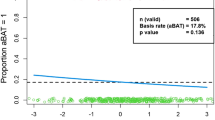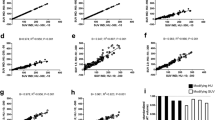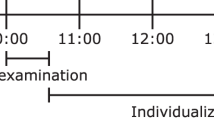Abstract
Purpose
It has been shown that warming patients prior to and during 18F-FDG uptake by controlling the room temperature can decrease uptake by brown adipose tissue (BAT). The aim of this study is to determine if this effect is subject to seasonal variation.
Methods
A retrospective review was conducted of all patients referred for whole-body 18F-FDG PET between December 2006 and December 2008. After December 2007, all patients were kept in the PET injection room at a constant 24°C for 30 min before and until 1 h following FDG administration. Patients over 22 years of age and those who received pre-medication known to reduce FDG uptake by BAT were excluded. One hundred and three patients were warmed to 24°C prior to scanning. The number of patients showing uptake by BAT in this group was compared to a control group of 99 patients who underwent PET prior to December 2007 when the injection room temperature was 21°C.
Results
Uptake by BAT occurred in 9% of studies performed after patient warming (24°C), compared to 27% of studies performed on the control group (21°C) (p < 0.00001). The effect of warming on decreasing FDG accumulation in BAT was statistically significant in the winter (p < 0.005) and summer (p < 0.001). However, in the spring and autumn, though the effect of warming on decreasing FDG accumulation in BAT was evident, it was not statistically significant (p > 0.05).
Conclusion
Maintaining room temperature at a constant 24°C for 30 min prior to and 1 h after IV tracer administration significantly decreases FDG uptake by BAT in children. This effect is greatest in the summer and winter.



Similar content being viewed by others
References
Gessner K. Conradi Gesneri medici Tigurini Historiae Animalium: Lib 1—De Quadrupedibus Viviparis. 1551.
Cannon B, Nedergaard J. Developmental biology: neither fat nor flesh. Nature 2008;454:947–8.
Rosen ED, Spiegelman BM. Adipocytes as regulators of energy balance and glucose homeostasis. Nature 2006;444:847–53.
Ronti T, Lupattelli G, Mannarino E. The endocrine function of adipose tissue: an update. Clin Endocrinol (Oxf) 2006;64:355–65.
Lowell BB, Susulic V, Hamann A, Lawitts JA, Himms-Hagen J, Boyer BB, et al. Development of obesity in transgenic mice after genetic ablation of brown adipose tissue. Nature 1993;366:740–2.
Yang X, Enerbäck S, Smith U. Reduced expression of FOXC2 and brown adipogenic genes in human subjects with insulin resistance. Obes Res 2003;11:1182–91.
Cypess AM, Lehman S, Williams G, Tal I, Rodman D, Goldfine AB, et al. Identification and importance of brown adipose tissue in adult humans. N Engl J Med 2009;360(15):1509–17.
Au-Yong ITH, Thorn N, Ganatra R, Perkins AC, Symonds ME. Brown adipose tissue and seasonal variations in humans. Diabetes 2009;58:2583–7.
Wehrli NE, Bural G, Houseni M, Alkhawaldeh K, Alavi A, Torigian DA. Determination of age-related changes in structure and function of skin, adipose tissue, and skeletal muscle with computed tomography, magnetic resonance imaging, and positron emission tomography. Semin Nucl Med 2007;37:195–205.
Himms-Hagen J. Thermogenesis in brown adipose tissue as an energy buffer. Implications for obesity. N Engl J Med 1984;311:1549–58.
Hany TF, Gharehpapagh E, Kamel EM, Buck A, Himms-Hagen J, von Schulthess GK. Brown adipose tissue: a factor to consider in symmetrical tracer uptake in the neck and upper chest region. Eur J Nucl Med Mol Imaging 2002;29:1393–8.
Cohade C, Mourtzikos K, Wahl R. “USA-Fat”: prevalence is related to ambient outdoor temperature—evaluation with 18F-FDG PET/CT. J Nucl Med 2003;44:1267–70.
Kim S, Krynyckyi BR, Machac J, Kim CK. Temporal relation between temperature change and FDG uptake in brown adipose tissue. Eur J Nucl Med Mol Imaging 2008;35(5):984–9.
Cohade C, Osman M, Pannu HK, Wahl RL. Uptake in supraclavicular area fat (“USA-Fat”): description on 18F-FDG PET/CT. J Nucl Med 2003;44:170–6.
Nedergaard J, Bengtsson T, Cannon B. Unexpected evidence for active brown adipose tissue in adult humans. Am J Physiol Endocrinol Metab 2007;293(2):E444–52.
Heaton JM. The distribution of brown adipose tissue in the human. J Anat 1972;112:35–9.
Paidisetty S, Blodgett TM. Brown fat: atypical locations and appearances encountered in PET/CT. AJR Am J Roentgenol 2009;193(2):359–66.
Truong MT, Erasmus JJ, Munden RF, Marom EM, Sabloff BS, Gladish GW, et al. Focal FDG uptake in mediastinal brown fat mimicking malignancy: a potential pitfall resolved on PET/CT. AJR Am J Roentgenol 2004;183(4):1127–32.
Gelfand MJ, O’Hara SM, Curtwright LA, Maclean JR. Pre-medication to block [(18)F]FDG uptake in the brown adipose tissue of pediatric and adolescent patients. Pediatr Radiol 2005;35(10):984–90.
Parysow O, Mollerach AM, Jager V, Racioppi S, San Roman J, Gerbaudo VH. Low-dose oral propranolol could reduce brown adipose tissue F-18 FDG uptake in patients undergoing PET scans. Clin Nucl Med 2007;32(5):351–7.
Söderlund V, Larsson SA, Jacobsson H. Reduction of FDG uptake in brown adipose tissue in clinical patients by a single dose of propranolol. Eur J Nucl Med Mol Imaging 2007;34(7):1018–22.
Sturkenboom MG, Hoekstra OS, Postema EJ, Zijlstra JM, Berkhof J, Franssen EJ. A randomised controlled trial assessing the effect of oral diazepam on 18F-FDG uptake in the neck and upper chest region. Mol Imaging Biol 2009;11(5):364–8.
Tatsumi M, Engles JM, Ishimori T, Nicely O, Cohade C, Wahl RL. Intense (18)F-FDG uptake in brown fat can be reduced pharmacologically. J Nucl Med 2004;45(7):1189–93.
Christensen CR, Clark PB, Morton KA. Reversal of hypermetabolic brown adipose tissue in F-18 FDG PET imaging. Clin Nucl Med 2006;31(4):193–6.
Garcia CA, Van Nostrand D, Atkins F, Acio E, Butler C, Esposito G, et al. Reduction of brown fat 2-deoxy-2-[F-18]fluoro-D-glucose uptake by controlling environmental temperature prior to positron emission tomography scan. Mol Imaging Biol 2006;8(1):24–9.
Zukotynski KA, Fahey FH, Laffin S, Davis R, Treves ST, Grant FD, et al. Constant ambient temperature of 24 degrees C significantly reduces FDG uptake by brown adipose tissue in children scanned during the winter. Eur J Nucl Med Mol Imaging 2009;36(4):602–6.
National Weather Service Forecast Office. http://www.weather.gov/climate/. Accessed 29 Dec 2009.
Garcia CA, Van Nostrand D, Majd M, Atkins F, Acio E, Sheikh A, et al. Benzodiazepine-resistant “brown fat” pattern in positron emission tomography: two case reports of resolution with temperature control. Mol Imaging Biol 2004;6(6):368–72.
Rousseau C, Bourbouloux E, Campion L, Fleury N, Bridji B, Chatal JF, et al. Brown fat in breast cancer patients: analysis of serial (18)F-FDG PET/CT scans. Eur J Nucl Med Mol Imaging 2006;33(7):785–91.
Saito M, Okamatsu-Ogura Y, Matsushita M, Watanabe K, Yoneshiro T, Nio-Kobayashi J, et al. High incidence of metabolically active brown adipose tissue in healthy adult humans: effects of cold exposure and adiposity. Diabetes 2009;58(7):1526–31.
Lazar MA. How obesity causes diabetes: not a tall tale. Science 2005;307:373–5.
Calle EE, Rodriquez C, Walker-Thurmond K, Thun MJ. Overweight, obesity, and mortality from cancer in a prospectively studied cohort of U.S. adults. N Engl J Med 2003;348:1625–38.
Kushi LH, Byers T, Doyle C, Bandera EV, McCullough M, McTiernan A, et al. American Cancer Society Guidelines on Nutrition and Physical Activity for cancer prevention: reducing the risk of cancer with healthy food choices and physical activity. CA Cancer J Clin 2006;56:254–81.
Author information
Authors and Affiliations
Corresponding author
Rights and permissions
About this article
Cite this article
Zukotynski, K.A., Fahey, F.H., Laffin, S. et al. Seasonal variation in the effect of constant ambient temperature of 24°C in reducing FDG uptake by brown adipose tissue in children. Eur J Nucl Med Mol Imaging 37, 1854–1860 (2010). https://doi.org/10.1007/s00259-010-1485-2
Received:
Accepted:
Published:
Issue Date:
DOI: https://doi.org/10.1007/s00259-010-1485-2




